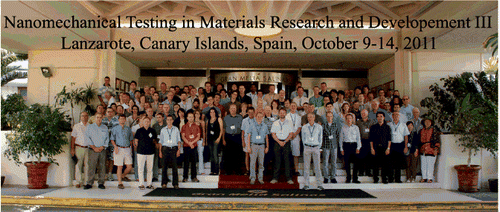Nanomechanical testing of materials has evolved over the last decade with new tools to study small-scale mechanical behavior with high precision in positioning and accurate acquisition of load and displacement data. Both micro- and nano-sized materials as well as microstructural components of bulk materials are in the research focus. The novel nanomechanical methods, which are frequently based on developments achieved over the last 20 years on nanoindentation systems and nanoindentation data interpretation, range from miniaturized compression and tensile testing to torsion, bending, fatigue, and fracture experiments. Most of the above mentioned methods are nowadays becoming commercially available for testing of materials with high spatial resolution to uncover the often unexpected mechanical material properties at small length scales. Further developments include nanomechanical testing at variable temperature and under controlled environments. Since a detailed understanding of nanomechanical behavior, e.g., confinement effects on the yield and fracture strength of single crystals, individual microstructural components like grain boundaries and hetero-interfaces, or multiphase nanostructured materials, is still in its infancy, combined efforts of experimentalists and theoreticians are required to advance to a state where quantitative laws for describing and ultimately for predicting the “nanomechanical” response can be formulated. Progress in understanding size effects in plasticity (“smaller is stronger”) for single crystalline metals based on intense research using nanomechanical testing approaches, in situ diffraction and electron microscopy experiments as well as length scale bridging simulations is well documented in the conference series Nano-mechanical testing in materials research and development, which started with a strong focus on instrumented indentation testing (Fodele Beach, Crete, Greece, October 9–14, 2005) and opened its venue to novel nanomechanical testing methods and its application to a fundamental understanding of mechanical properties at small dimensions with the second meeting in 2009 (Barga - Tuscany, Italy, October 11–16, 2009) and the third meeting of this conference series held in 2011 (Lanzarote, Canary Islands, Spain, October 9–14, 2011).
With the current issue of Philosophical Magazine, readers are brought up to date on the major improvements achieved since the first two conferences published in 2006 (“Instrumented Indentation Testing in Materials Research and Development”) Citation1 and 2011 (“Nano-mechanical testing in materials research and development”) Citation2. The topics addressed in all three issues range from:
| • | Fundamental studies in indentation testing | ||||
| • | FIB/lithography based nano- and micromechanical testing | ||||
| • | In situ techniques (synchrotron, electron microscopy…) | ||||
| • | Deformation mechanisms | ||||
| • | Modeling, with focus on molecular dynamics, discrete dislocation dynamics and crystal plasticity | ||||
| • | Novel preparation methods for micro- and nanoscale objects | ||||
| • | Testing of nanostructures, thin films and coatings | ||||
| • | Fatigue and fracture testing | ||||
| • | Polymeric and biomaterials | ||||
| • | Testing of metals, ceramics and composites | ||||
| • | Testing at higher temperatures and different environments | ||||
The strong and growing interest in this research field can be seen by the high number of citations for publications of the first two issues and the increasing number of participants at the conference series which reached 115 from 17 different nations in Lanzarote. The success of the conference is its informal style with many fruitful discussions, excellent lectures and poster presentations, entertaining poster previews, presentations of new devices from commercial partners and their strong financial support. Finally, the excellent and friendly handling of the conference logistics by Barbara Hickernell from Engineering Conferences International (ECI) is greatly appreciated.
The editors would also like to thank the organization committee of the 2011 conference:
Christian Motz, Austrian Academy of Sciences, Austria | |||||
Nigel M. Jennett, National Physical Laboratory, UK | |||||
Sang Ho Oh, Pohang University of Science and Technology, Korea | |||||
Alexander Hartmaier, ICAMS and Ruhr-Universität Bochum, Germany | |||||
George M. Pharr, University of Tennessee and Oak Ridge National Laboratory, USA | |||||
Johann Michler, EMPA, Switzerland | |||||
Gerhard Dehm (conference chair), University of Leoben and Austrian Academy of Sciences, Austria | |||||
for their enthusiasm in organizing the 2011 conference and encouraging participants to publish their work in this special issue. The editors express their thanks to all authors and reviewers for their contributions and efforts in creating another issue of the highest quality from this conference series.

References
- Jennett , NM , Pharr , GM and McHargue , CJ . (eds.), Phil. Mag. 86 (33–35) (2006)
- Jennett , NM , Göken , M and Durst , K . (eds.), Phil. Mag. 91 (1035–1036) (2011)